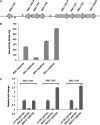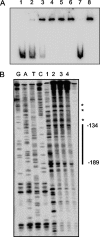Regulation of transcription by SMU.1349, a TetR family regulator, in Streptococcus mutans
- PMID: 21965566
- PMCID: PMC3232899
- DOI: 10.1128/JB.06122-11
Regulation of transcription by SMU.1349, a TetR family regulator, in Streptococcus mutans
Abstract
The TetR family of transcriptional regulators is ubiquitous in bacteria, where it plays an important role in bacterial gene expression. Streptococcus mutans, a gram-positive pathogen considered to be the primary etiological agent in the formation of dental caries, encodes at least 18 TetR regulators. Here we characterized one such TetR regulator, SMU.1349, encoded by the TnSmu2 operon, which appeared to be acquired by the organism via horizontal gene transfer. SMU.1349 is transcribed divergently from the rest of the genes encoded by the operon. By the use of a transcriptional reporter system and semiquantitative reverse transcription-PCR (RT-PCR), we demonstrated that SMU.1349 activates the transcription of several genes that are encoded within the TnSmu2 operon. Gel mobility shift and DNase I footprinting assays with purified SMU.1349 protein demonstrated binding to the intergenic region between SMU.1349 and the TnSmu2 operon; therefore, SMU.1349 is directly involved in gene transcription. Using purified S. mutans RpoD and Escherichia coli RNA polymerase, we also demonstrated in an in vitro transcription assay that SMU.1349 could activate transcription from the TnSmu2 operon promoter. Furthermore, we showed that SMU.1349 could also repress transcription from its own promoter by binding to the intergenic region, suggesting that SMU.1349 acts as both an activator and a repressor. Thus, unlike most of the TetR family proteins, which generally function as transcriptional repressors, SMU.1349 is unique in that it can function as both.
Figures






Similar articles
-
CovR alleviates transcriptional silencing by a nucleoid-associated histone-like protein in Streptococcus mutans.J Bacteriol. 2012 Apr;194(8):2050-61. doi: 10.1128/JB.06812-11. Epub 2012 Feb 17. J Bacteriol. 2012. PMID: 22343292 Free PMC article.
-
Activation of the SMU.1882 transcription by CovR in Streptococcus mutans.PLoS One. 2010 Nov 22;5(11):e15528. doi: 10.1371/journal.pone.0015528. PLoS One. 2010. PMID: 21124877 Free PMC article.
-
SMU_1361c regulates the oxidative stress response of Streptococcus mutans.Appl Environ Microbiol. 2024 Feb 21;90(2):e0187123. doi: 10.1128/aem.01871-23. Epub 2024 Feb 1. Appl Environ Microbiol. 2024. PMID: 38299814 Free PMC article.
-
Autoregulation of the Streptococcus mutans SloR Metalloregulator Is Constitutive and Driven by an Independent Promoter.J Bacteriol. 2018 Jun 25;200(14):e00214-18. doi: 10.1128/JB.00214-18. Print 2018 Jul 15. J Bacteriol. 2018. PMID: 29735764 Free PMC article.
-
The TetR family of transcriptional repressors.Microbiol Mol Biol Rev. 2005 Jun;69(2):326-56. doi: 10.1128/MMBR.69.2.326-356.2005. Microbiol Mol Biol Rev. 2005. PMID: 15944459 Free PMC article. Review.
Cited by
-
Substrate-dependent activation of the Vibrio cholerae vexAB RND efflux system requires vexR.PLoS One. 2015 Feb 19;10(2):e0117890. doi: 10.1371/journal.pone.0117890. eCollection 2015. PLoS One. 2015. PMID: 25695834 Free PMC article.
-
Mutations in AcrR and RNA Polymerase Confer High-Level Resistance to Psoralen-UVA Irradiation.J Bacteriol. 2023 Jun 27;205(6):e0012623. doi: 10.1128/jb.00126-23. Epub 2023 May 30. J Bacteriol. 2023. PMID: 37249472 Free PMC article.
-
CovR alleviates transcriptional silencing by a nucleoid-associated histone-like protein in Streptococcus mutans.J Bacteriol. 2012 Apr;194(8):2050-61. doi: 10.1128/JB.06812-11. Epub 2012 Feb 17. J Bacteriol. 2012. PMID: 22343292 Free PMC article.
-
Genomic instability of TnSMU2 contributes to Streptococcus mutans biofilm development and competence in a cidB mutant.Microbiologyopen. 2019 Dec;8(12):e934. doi: 10.1002/mbo3.934. Epub 2019 Oct 9. Microbiologyopen. 2019. PMID: 31599128 Free PMC article.
-
Decoding gene expression dynamics in planktonic and biofilm cells of Streptococcus mutans: regulation and role of mutanofactin genes in biofilm formation.Front Oral Health. 2025 Jan 17;6:1535034. doi: 10.3389/froh.2025.1535034. eCollection 2025. Front Oral Health. 2025. PMID: 39896144 Free PMC article.
References
-
- Aravind L., Anantharaman V., Balaji S., Babu M. M., Iyer L. M. 2005. The many faces of the helix-turn-helix domain: transcription regulation and beyond. FEMS Microbiol. Rev. 29:231–262 - PubMed
Publication types
MeSH terms
Substances
Grants and funding
LinkOut - more resources
Full Text Sources

